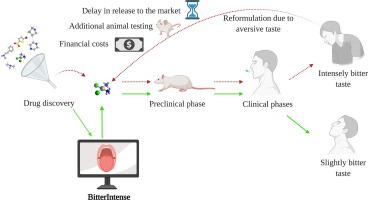Computational and Structural Biotechnology Journal ( IF 6 ) Pub Date : 2020-12-25 , DOI: 10.1016/j.csbj.2020.12.030 Eitan Margulis , Ayana Dagan-Wiener , Robert S. Ives , Sara Jaffari , Karsten Siems , Masha Y. Niv

|
Drug development is a long, expensive and multistage process geared to achieving safe drugs with high efficacy. A crucial prerequisite for completing the medication regimen for oral drugs, particularly for pediatric and geriatric populations, is achieving taste that does not hinder compliance. Currently, the aversive taste of drugs is tested in late stages of clinical trials. This can result in the need to reformulate, potentially resulting in the use of more animals for additional toxicity trials, increased financial costs and a delay in release to the market. Here we present BitterIntense, a machine learning tool that classifies molecules into “very bitter” or “not very bitter”, based on their chemical structure. The model, trained on chemically diverse compounds, has above 80% accuracy on several test sets. Our results suggest that about 25% of drugs are predicted to be very bitter, with even higher prevalence (~40%) in COVID19 drug candidates and in microbial natural products. Only ~10% of toxic molecules are predicted to be intensely bitter, and it is also suggested that intense bitterness does not correlate with hepatotoxicity of drugs. However, very bitter compounds may be more cardiotoxic than not very bitter compounds, possessing significantly lower QPlogHERG values. BitterIntense allows quick and easy prediction of strong bitterness of compounds of interest for food, pharma and biotechnology industries. We estimate that implementation of BitterIntense or similar tools early in drug discovery process may lead to reduction in delays, in animal use and in overall financial burden.
中文翻译:

分子的强烈苦味:机器学习可加速药物发现
药物开发是一个漫长,昂贵且多阶段的过程,旨在获得安全高效的药物。完成口服药物尤其是儿科和老年患者的口服药物治疗方案的关键前提是获得不会妨碍依从性的味道。当前,在临床试验的后期测试药物的厌恶味道。这可能导致需要重新配方,可能导致将更多的动物用于其他毒性试验,增加财务成本并延迟投放市场。在这里,我们介绍BitterIntense,这是一种机器学习工具,可以根据分子的化学结构将分子分为“非常苦”或“不是很苦”。该模型在化学上多样化的化合物上进行了训练,在多个测试集上的准确率均超过80%。我们的结果表明,预计约25%的药物会非常苦,在COVID19候选药物和微生物天然产物中的患病率甚至更高(约40%)。预计只有约10%的有毒分子具有强烈的苦味,并且还表明,强烈的苦味与药物的肝毒性无关。但是,非常苦的化合物可能比不是很苦的化合物更具心脏毒性,它们的QPlogHERG值明显较低。BitterIntense可以快速轻松地预测食品,制药和生物技术行业所关注化合物的强烈苦味。我们估计在药物开发过程的早期实施BitterIntense或类似工具可能会减少延误,减少动物使用和总体经济负担。在候选COVID19和微生物天然产物中的患病率更高(约40%)。预计只有约10%的有毒分子具有强烈的苦味,并且还表明,强烈的苦味与药物的肝毒性无关。但是,非常苦的化合物可能比不很苦的化合物更具心脏毒性,它们的QPlogHERG值明显较低。BitterIntense可以快速轻松地预测食品,制药和生物技术行业所关注化合物的强烈苦味。我们估计在药物开发过程的早期实施BitterIntense或类似工具可能会减少延误,减少动物使用和总体经济负担。在候选COVID19和微生物天然产物中的患病率更高(约40%)。预计只有约10%的有毒分子具有强烈的苦味,并且还表明,强烈的苦味与药物的肝毒性无关。但是,非常苦的化合物可能比不是很苦的化合物更具心脏毒性,它们的QPlogHERG值明显较低。BitterIntense可以快速轻松地预测食品,制药和生物技术行业所关注化合物的强烈苦味。我们估计在药物开发过程的早期实施BitterIntense或类似工具可能会减少延误,减少动物使用和总体经济负担。并且还表明,强烈的苦味与药物的肝毒性无关。但是,非常苦的化合物可能比不很苦的化合物更具心脏毒性,它们的QPlogHERG值明显较低。BitterIntense可以快速轻松地预测食品,制药和生物技术行业所关注化合物的强烈苦味。我们估计在药物开发过程的早期实施BitterIntense或类似工具可能会减少延误,减少动物使用和总体经济负担。并且还表明,强烈的苦味与药物的肝毒性无关。但是,非常苦的化合物可能比不是很苦的化合物更具心脏毒性,它们的QPlogHERG值明显较低。BitterIntense可以快速轻松地预测食品,制药和生物技术行业所关注化合物的强烈苦味。我们估计在药物开发过程的早期实施BitterIntense或类似工具可能会减少延误,减少动物使用和总体经济负担。BitterIntense可以快速轻松地预测食品,制药和生物技术行业所关注化合物的强烈苦味。我们估计在药物开发过程的早期实施BitterIntense或类似工具可能会减少延误,减少动物使用和总体经济负担。BitterIntense可以快速轻松地预测食品,制药和生物技术行业所关注化合物的强烈苦味。我们估计在药物开发过程的早期实施BitterIntense或类似工具可能会减少延误,减少动物使用和总体经济负担。



























 京公网安备 11010802027423号
京公网安备 11010802027423号